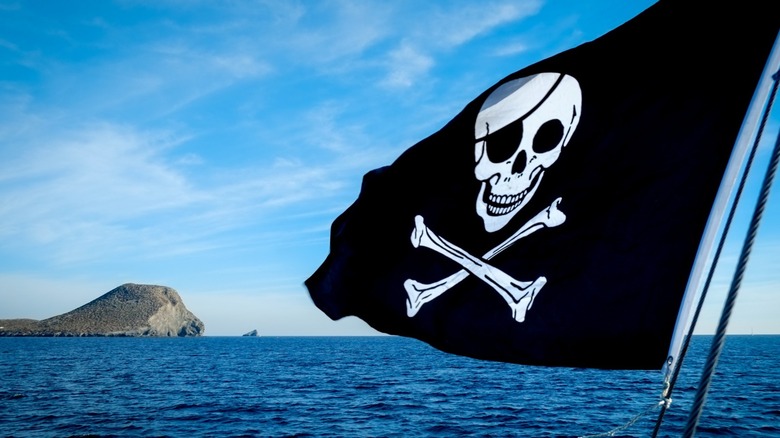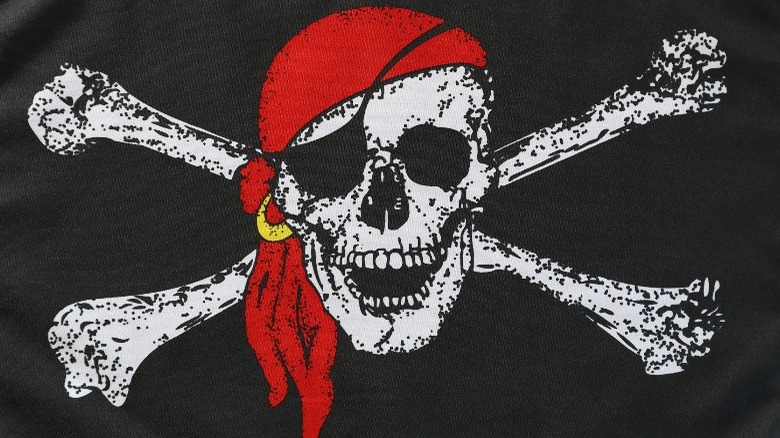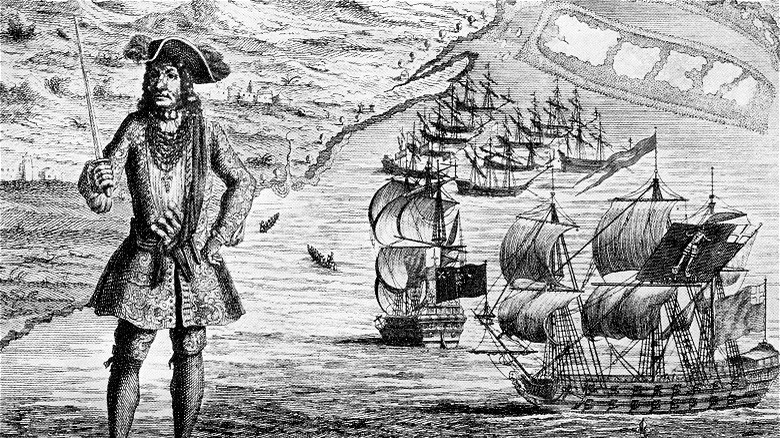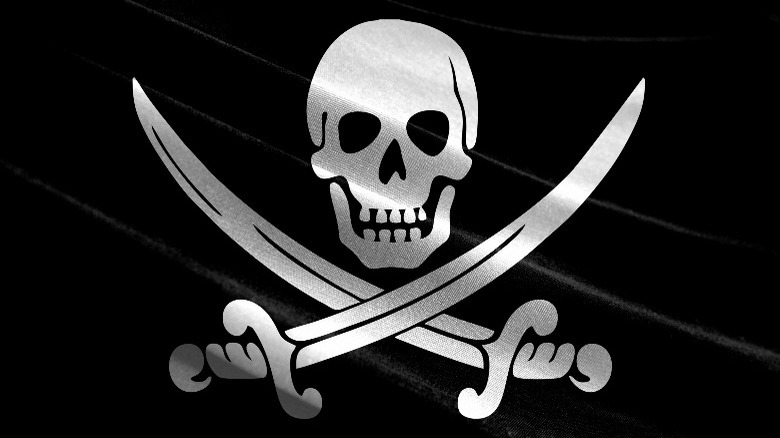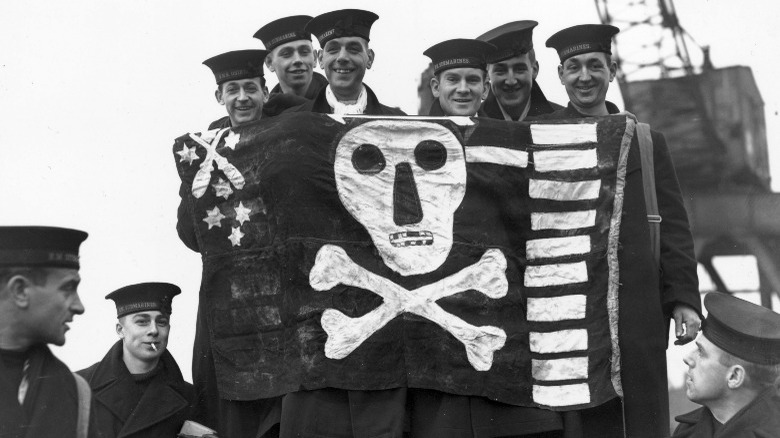The Violent History Of The Jolly Roger Flag Explained
Pirates are perhaps some of the most interesting yet terrifying figures in history. Today when we picture these marauders, we likely imagine something like Disney's Captain Hook, or Captain Jack Sparrow. Historically speaking though, pirates were very different from the cleaned up and romanticized images we see on the big screen. These sea-faring marauders were on a mission to plunder and you did not want to come across them.
The 18th century is often referred to as the "Golden Age of Piracy" (per World History Encyclopedia) due to the significant rise in the number of robberies of ships and ports around that time. As these pirates sailed around wreaking havoc, the legends of their exploits and symbols associated with their crimes began to grow. Over time, one of the most enduring images that became associated with the pirates was their flag, known as the Jolly Roger. Over the course of decades it struck fear into the hearts of all who had the displeasure of laying eyes on it, and has a violent history all its own.
A blurry beginning
Today we recognize a pirate flag by its distinct features. The white skull and crossbones against the stark black background is pretty hard to miss. According to All That's Interesting, this version of the flag we know today did not arrive on the scene until the 18th century. However, this kind of flag predates the 1700s. There is the possibility that the skull and crossbones originated with the Barbary pirates of North Africa a century earlier (per Heritage Daily).
Though the true origins of the Jolly Roger are unknown, today the skull and crossbones are the most easily identifiable component of the flag. However, there was a time when there were additional items or symbols added to the flags. Some of those included hourglasses, swords, and bleeding hearts (per All That's Interesting). There are multiple reports of flags that are different colors entirely, including red and green.
What was the flag for?
Though the flags flown by pirates were different from those used by other vessels, their purpose was still pretty much the same. According to Ancient Origins, the flags displayed by any given ship had one purpose, which was to convey a message. Generally the message that was trying to be relayed was where a vessel's allegiance lay.
Pirate ships were no different, in that they used flags for the same purpose. However, the messages they were conveying were not peaceful ones. If a pirate ship flew an all black flag, it meant that they would be attacking you and would give quarter if you did not resist (per Ancient Origins). If there was resistance, however, the flag flown by the pirate ship would be a red one, signaling that there would be no mercy. Ultimately, the goal was to inspire terror in those who saw the flag. It also was not until later that the solid-color flags changed and became the pirate flags we know today.
How The Jolly Roger Got Its Name
Along with its unique design features, the iconic pirate flag also developed a unique name: the Jolly Roger. The term "Jolly Roger" initially referred to any and all flags flown by pirates or privateers (per World History). Since then, it has become mostly synonymous with the recognizable image of the skull and crossbones.
Where the name 'Jolly Roger" originated is not known for sure. During the 18th century the term "Roger" was used to refer to various things, including wandering beggars and the Devil, and so it may have come from there. Additionally it may have come from the French phrase le jolie rouge, which translates to "the pretty red." This reportedly referred to the all-red flag that was used by pirates that signaled no quarter. The same phrase was also used as a nickname for the notorious pirate also known as Black Bart, who flew a flag bearing the skull and crossbones. Because of this there is speculation that is possibly where the name came from.
Variations of the Jolly Roger
Though we generally picture the Jolly Roger with just the standard skull and crossbones configuration, it turns out there are different types of this particular flag. The flag in the form that we recognize today appears to have become more commonplace during the 18th century (per All That's Interesting). One of the early mentions of this style of Jolly Roger is from 1700, described as having "crossbones, a death's head, and an hourglass."
From 1724 comes documentation of another infamous pirate, Francis Spriggs, flying a Jolly Roger as well. Spriggs' flag featured a skeleton holding a bleeding heart in one hand and an hourglass in the other. There were other variations of these Jolly Rogers which featured hearts dripping blood, swords, and skeletons. Whatever the elements of the various designs, before long everyone recognized these flags as symbols of terror and fear. Eventually there were fewer and fewer ships using these flags, but the recognition of them still lives on more than two centuries later.
The skull and crossbones today
While it is highly unlikely that you will see a Jolly Roger coming toward you next time you're out on a boat, there are places in modern times where you can see them. The Royal Navy flies their own versions of a Jolly Roger and have done so since World War I (per All That's Interesting). Each crew reportedly designs their own variations that are slightly different from the others. This tradition reportedly started when someone criticized the Navy, comparing them to pirates.
In addition to still being used by the Royal Navy, the symbol of the skull and crossbones became a part of literary and film culture as well. Versions of the Jolly Roger were incorporated into stories in the 19th century such as "The Coral Island" (1857) and "Treasure Island" (1882) (per World History). The flag has also been seen multiple times on the big screen, most recently (per IMDb) in films like the "Pirates of the Caribbean" franchise.
